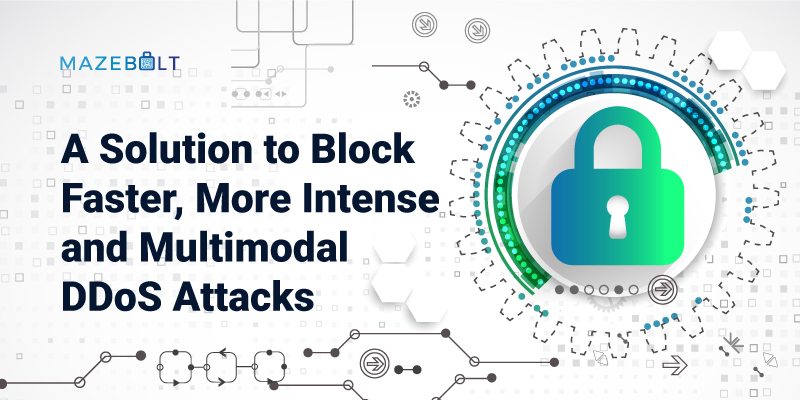Block Faster, More Intense, and Multimodal DDoS Attacks Solution
Since the first recorded DDoS attack in the mid-90s, attackers have continued to find novel techniques to bring down online networks. As technology has advanced in the past two decades, so have the attackers. At the beginning of the DDoS mayhem, the attackers’ sole purpose was to create a stir by making the target network service unavailable; with time, they learned tactics to escalate DDoS attacks to cause the maximum destruction. The DDoS threat landscape evolution has resulted in a recent phenomenon where attacks have become intense, faster, and more sophisticated.
DDoS attackers exploit vulnerabilities in network architecture, network protocols, and service facilities using different vectors.
DDoS attacks are grouped into three broad categories:
-
Volumetric Attacks
Commonly known as floods, volumetric attacks overwhelm the target network bandwidth by sending a large volume of requests until the online-traffic pipeline gets blocked, and genuine users face service unavailability. Attackers use hijacked devices, spoofed IP addresses, and amplification techniques to create unmanageable network traffic.
-
Protocol Attacks
An internet protocol is a set of rules applied for seamless communication between computing devices. Attackers exploit vulnerabilities in the protocols and overwhelm core services, such as routers, firewalls, or load balancers that forward requests to the target network. Protocol attacks are launched in Layer 3 or Layer 4 of the OSI model. The most common examples are TCP SYN Flood, Empty Connection Flood, and UDP Flood.
-
Application Attacks
Application layer attacks in layer 7 target web application-specific resources and overwhelm their functions. HTTP floods are the most common types of application attacks. Such attacks trigger extensive file downloads or form submissions on the website, exhausting the resources. Because these requests appear to be legitimate, mitigating DDoS attacks becomes difficult.
Faster, More Intense, and Multimodal DDoS Attacks
Using multiple DDoS vectors, attackers simultaneously launch more than one type of attack and increase the chances of a successful DDoS attack. For example, an attacker can add different vector layers or modify the vector in response to the mitigation solution; and dodge the defense system by changing the attack strategy every few minutes. In this way, if one vector fails, the other hits the target network within seconds before mitigation can react. In 2016, attackers created a record when they attacked Dyn, a popular Domain Name System (DNS) provider. 10s of million IP addresses associated with the Mirai botnet amplified the attack. It was a sophisticated attack across multiple attack vectors and internet locations, and the damage resulted in a downtime of nearly 2 hours. Multi-vector DDoS attacks continue to surge in unforeseen patterns, and the change in the type of vectors is rapid and highly unpredictable.
Another trend in the DDoS landscape is the increase in the frequency of short, low-volume DDoS attacks that operate in less than 10Gbps in volume and less than 10 minutes in duration. A report published by Securelist highlights a growing phenomenon where the average DDOS attack duration in Q3 (2020) continued to be shorter than the previous records. Report data explains the rise in the number of fast, ultrashort attacks and multi-day ones (this time by a significant 5.09 p.p.)
Short-duration attacks can bypass the configuration threshold that usually ignores such a low level of activity. They are easy to launch, inexpensive, damaging as large attacks, and, therefore, more popular. Attackers use low-volume attacks to create smokescreens and distract security officers from a more damaging motive, usually data theft. For example, during the Carphone Warehouse websites breach, attackers produced junk traffic as a smokescreen before breaking into systems and stealing the personal details of 2.4m customers. In many DDoS events, attackers remain invisible and rehearse smaller attacks to improve attack techniques. Anyhow, organizations suffer from latency and service outages. Despite several high-volume DDoS attacks making it to the headlines over the past year, these frequent-brief attacks continue to be the norm and pose a hidden security threat. Because of the limited vulnerability visibility, security officers cannot stop the outburst of shorter attacks immediately without avoiding downtime.
A Solution to Block DDoS Attacks
DDoS attacks are successful mainly because attackers are able to exploit vulnerabilities before security personnel and mitigation solutions can identify and close them. If security officers get access to real-time visibility reports of their surface risks, they can be more prepared to stop DDoS attacks. When organizations remediate ongoing vulnerabilities in their networks, DDoS attacks cannot affect business continuity; however, most of the vulnerabilities remain detected until targeted organizations are attacked and suffer from downtime.
Organizations can now block all DDoS attacks and avoid any downtime by deploying an ultimate DDoS Protection such as RADAR™.
Currently, all DDoS protection solutions deployed without RADAR™ require downtime to identify potential DDoS vulnerability points. However, RADAR™ detects and remediates DDoS vulnerabilities with no downtime. The ultimate DDoS protection solution continuously generates easy-to-understand analytical reports on comprehensive visibility across all networks. Security personnel get real-time vulnerability visibility insights facing no disruption to the network. Therefore, they can fine-tune the deployed mitigation policies to block newfound vulnerabilities, reduce attack surface risks and cut off a potential DDoS attack.
Organizations can optimize their DDoS protection’s overall efficiency by deploying RADAR™ because it adapts to dynamic environment changes, works with any mitigation solution, and ensures business continuity.
Click here to learn more about RADAR™
About MazeBolt
Israel-based MazeBolt is an innovation leader in cybersecurity with over two decades of experience in pioneering DDoS protection solutions. The company’s new flagship product, RADAR™, is a patented, new technology. It offers DDoS protection through automated DDoS simulations on live production with zero downtime. Working in conjunction with any mitigation solution installed. Its unique capabilities have ensured business continuity and full DDoS security posture for enterprises worldwide, including Fortune 1000 & NASDAQ-listed companies.







